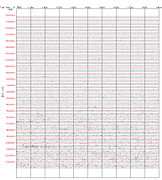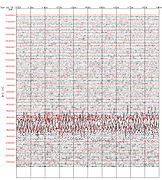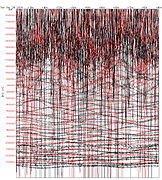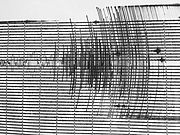Seismogram
![]()
This article or subsequent section is not sufficiently supported by evidence (for example, itemizations). Information without sufficient evidence may be removed soon. Please help Wikipedia by researching the information and adding good supporting evidence.
The article contains many statements without a source.
A seismogram is the graphical recording of movements of the ground or buildings as a function of time by means of a seismograph, which are usually caused by earthquake waves, but also by other natural or man-made events. Such devices were first used in 1875; in 1889, waves from the far field of an earthquake were recorded (unintentionally) for the first time in Potsdam, and in 1893, the first seismograph was installed in Stuttgart. They are essential for earthquake measurement based on the Richter scale.
Seismograms in the narrower sense, however, are only measurements of acceleration. Velocities and displacements are then derived from these so-called accelerograms.
From seismograms, conclusions can be drawn about the characteristics of the source of the shaking, such as the location, strength and rupture mechanics of earthquakes, of volcanic activity, of strong explosions, but also of wind loads or traffic-induced vibration inputs into structures such as high-rise buildings or bridges. In geophysics, so-called far-field seismograms are analyzed to draw conclusions about the internal structure of the earth, since earthquake waves propagate along different paths in the earth's body and are, for example, refracted, diffracted or reflected in a characteristic way at certain layers of the earth's crust, mantle and core. Seismograms can also be used to determine the natural vibration frequency of structures.
Historically, seismograms were recorded for a long time by means of line recorders, which wrote down the measured value continuously as a function of time on a rotating paper roll. Some devices used springs on conventional paper, while other apparatus used light beams on photosensitive paper. Today, virtually all seismograms are still digitized in the instrument to facilitate and speed real-time remote transmission and subsequent computerized analysis. Occasionally, classical seismographs are still used today, mainly for illustrative presentations to the public.
A seismogram always consists of three diagrams, for the three axes (vertical, 2× horizontal) of ground acceleration or, derived, velocity or displacement. There is no preferred alignment of the measuring instruments, since the direction of incidence of the oscillations to be recorded cannot be predicted. Contrary to popular belief, the so-called primary earthquake vibrations (P-waves, S-waves) always arrive at a site from below, since the vibrations originating from the rupture propagate faster in the solid and dense deep rock of the earth's crust than on the weathered and comparatively loose earth's surface.
Only so-called surface waves, such as Rayleigh waves or Love waves, which arise from the primary waves at layer boundaries, arrive at the measuring device from horizontal directions.
· 
Nuclear bomb explosion on Mururoa, September 5, 1995, magnitude 4.8
· 
Strong earthquake near Nicobar Islands, July 24, 2005, magnitude 7.3
· 
2004 Indian Ocean earthquake ("tsunami earthquake"), December 26, 2004, magnitude 9.3
· 
American Canyon Earthquake 2014
The seismograms shown above are intended to give a visual impression of different magnitudes and were not selected according to scientific aspects.
The task is to infer causes from such images, and to do so as quantitatively as possible. This is mathematically called a typical "inverse problem". The solution is generally possible, even in practice.
Questions and Answers
Q: What is a seismogram?
A: A seismogram is a record of an earthquake-induced motion at a measuring station as a function of time.
Q: How are seismograms usually taken?
A: Seismograms are usually taken by seismometers.
Q: In which axes do seismometers record motions?
A: Seismometers record motions in three cartesian axes (x, y, and z), with the z axis perpendicular to the Earth's surface and the x- and y- axes parallel to the surface.
Q: How were seismograms historically recorded?
A: Historically, seismograms were recorded on paper attached to rotating drums. Some used pens on ordinary paper. Others used light beams to expose photosensitive paper.
Q: How are seismograms recorded today?
A: Today, almost all seismograms are recorded digitally to make analysis by computer easier.
Q: Why are seismograms important?
A: Seismograms are very important for measuring earthquakes using the Richter scale.
Q: What device is used to take seismograms?
A: Seismometers are used to take seismograms.
Search within the encyclopedia